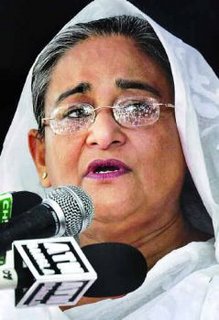 The Farakka barrage still remains as a thorn in India Bangladesh relation. Farakka Barrage is located in India 11 miles from the borders of Bangladesh. Construction of the Farakka Barrage was started by India in 1960 unilaterally violating the international norms of any construction for diversion of water on any international river. It was completed in 1974 to divert Ganges River water into the Bhagirati-Hooghly River in order to flush out the accumulating silt from the bed of the river and thereby improving the navigability at the Kolkata Port.
The Farakka barrage still remains as a thorn in India Bangladesh relation. Farakka Barrage is located in India 11 miles from the borders of Bangladesh. Construction of the Farakka Barrage was started by India in 1960 unilaterally violating the international norms of any construction for diversion of water on any international river. It was completed in 1974 to divert Ganges River water into the Bhagirati-Hooghly River in order to flush out the accumulating silt from the bed of the river and thereby improving the navigability at the Kolkata Port. Razib Rashedin describes:
"India approached Bangladesh for test operation of the Farakka Barrage and feeder canal. The then prime Minister Sk. Mujib agreed to India's proposal for test operation of the barrage and feeder canal. Initially in 1975 India was allowed to divert flows varying from 11000 cusec to 16000 cusec for a period of 41 days from 21 April to 31 May '75 with the understanding that India will not operate feeder canal until a final agreement was reached between India and Bangladesh on the sharing of Ganges water. Violating this understanding India started diverting the Ganges water in the upstream unilaterally in 1976 & 1977.The Immediate Effect on Bangladesh:
Unilateral withdrawal of Ganges water during the dry months resulted serious adverse effects on environment, agriculture, industries, fisheries, navigation, river regime, salinity contamination in the surface and ground water, etc. in the southwestern and western areas of Bangladesh. Covering almost 20% of countries area is 30,000 sq. km inhabited by about 30 million people."
a) Reduction in agricultural products due to insufficient water for irrigation.
b) Reduction in aquatic population.
c) Transportation problems: boats rendered useless; tributaries are dry during dry season.
d) Increased salinity threatening crops, animal life drinking water, and industrial activities in southwest Bangladesh.
Long-Term Impacts on Bangladesh:
a) One fourth of the fertile agricultural land will become wasteland due to a shortage of water.
b) Thirty million lives are affected through environmental and economical ruin.
c) An estimated annual economic loss of over half a billion dollars in agricultural, fisheries, navigation and industries.
d) Frequent flooding due to environmental imbalance and changes in the natural flow of the Ganges.
(source)
Time line in water sharing:
a) In April 1975, Bangladesh agreed to a trial operation of the Farakka Barrage for the period from April 21-May 31 to divert 11,000-16,000 cfs. India, however, continued to divert the full capacity of 40,000 cfs after May 31.
b) On November 26, 1976 the U.N. General Assembly adopted a consensus statement directing the parties to arribe at a fair and expeditious settelement.
c) On November 5, 1977 the Ganges Waters Agreement was signed, assuring 34,500 cfs for Bangladesh.
d) The five-year treaty expired in 1982 and after several shorter extensions, lapsed entirely in 1989. During the period from 1978 to 82 Bangladesh received more than its share for all the years excepting one when the flow at Farakka fall unexpectedly but the India released the guaranteed minimum flow. MOU signed in 1982 without the guarantee clause was expired in 1985 and extended to 1988 through two other similar extensions. From 1989 onward India refused to come to any deal with the Bangladesh on Ganges water sharing.
e) No treaty or agreement existed till 1996 during which the average low flow has come down to 10,000 to 12,000 cusec with one extreme event of 9000 cusec. India was diverting the water at their will with complete disregard of Bangladesh's fair share.
f) On 12 December 1996, Prime Ministers Sheikh Hasina Wajed and H. D. Deve Gowda, of Bangladesh and India, respectively, signed a thirty year long treaty in New Delhi on the sharing of Ganges water. The Treaty addresses the heart of the conflict: water allocation (35,000 cusecs) during the five months of the dry season (January-May). During the rest of the year, there is sufficient water that India can operate the Farakka diversion without creating problems for Bangladesh. The treaty stipulates that below a certain flow rate, India and Bangladesh will each share half of the water. Above a certain limit, Bangladesh will be guaranteed a certain minimum level, and if the water flow exceeds a given limit, India will withdraw a given amount, and the balance will be received by Bangladesh (which will be more than 50%).
g) Due to the absence of cooperation and implementation mechanism, the treaty in reality did not solve the problem. The very first season following signing of the treaty, in April 1997, India and Bangladesh were involved in their first dispute over cross-boundary flow. -Water passing through the Farakka dam dropped below the minimum provided in the treaty, prompting Bangladesh to request a review of the state of the watershed. (source)
h) A critical evaluation of the 1996 treaty.
Bangladesh has again asked India for discharge of more water through the Farakka barrage to keep river routes in its territory navigable.
Related resource: International Farakka Committee.
































